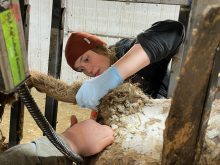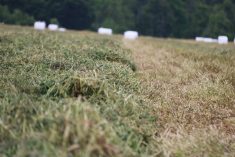BANFF, Alta. – The company that helped open the West has come full circle.
By relocating 730 people this summer to its new Calgary headquarters, CP Rail plans to be a leaner, more efficient operation.
Dan Stirling of CP unveiled some of the corporation’s new strategies at the recent Western Barley Growers Association meeting.
Staff from Montreal, Toronto, Winnipeg and the United States will be centralized within three divisions in the restructured corporation.
A commercial area will handle agricultural products like grain as well as other commodities like fertilizer and coal. Operational and support areas look after information and finances.
Read Also

Environmental farm group has Ottawa’s attention
In 2021, Farmers for Climate Solutions published a report on how Canada should reduce emissions from agriculture. Not long after, the federal government implemented most of the recommendations in the report.
The grain division will be managed by three directors including Stirling in Calgary. Another will be located in Winnipeg and the third will work out of Minneapolis.
Grain logistics will be handled from Calgary by a special team planning day-to-day railroad operations of transportation, field operations and customer service.
The team will operate a main computer system to help spot empty cars, note if they’re loaded and where they’re headed.
Another priority is moving grain based on customers’ need on a just-in-time basis.
“If we don’t figure out how to do that, others will,” said Stirling.
“When we’re really pushing the grain out, often we don’t have the right grain at the right port at the right time. We’ve got to correct that.”
CP wants car allocation incentives for efficient car use that include more 10-hour loading periods at elevators. It is also seeking weekend loading and unloading rather than staff working five days a week during daylight hours.
At the same time the corporation is trying to get a better grip on its operations and its cash problems.
Revenue is down seven percent but costs are up and new equipment is needed. CP spent $500 million in 1995 compared to average annual expenditures of $265 million between 1989 and 1994.
“We finally reached the point where we had to put more money back into the rail line,” said Stirling.
“We’re going to have to increase the capital we put back in the railways if we’re going to survive. We’re going to have to go through some radical changes in order to allow us to do that,” said Stirling.
For starters, CP needs 40 new engines at a cost of $100 million a year. The average age of a CP locomotive is 24 years.
In 1995, 83 new locomotives were acquired for $200 million. Three can do what five of the old ones handled, said Stirling.
Of that purchase, 53 will take coal to Roberts Bank on the west coast and the remaining 30 will haul grain.
While CP’s volume of products hauled has risen 15 percent since 1991, its work force has been reduced by 18 percent. Today, the company employs about 22,000 people, including its American-based employees, said Stirling.
In 1996 it is looking at a 25 percent reduction in professional administrative staff for a savings of $100 million.
“Unfortunately that’s going to result in the reduction of 1,400 to 1,500 people in our management,” said Stirling.
With the departure of these people, more decisions will be made at the lower levels.















